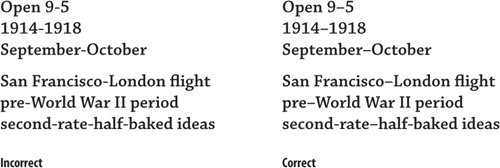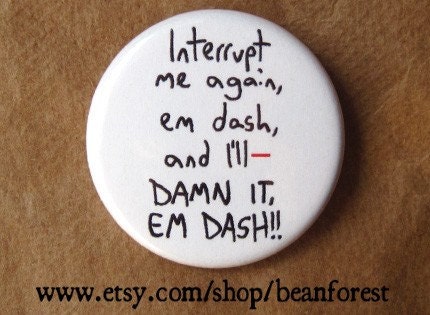These marks are all used to separate or conjoin items, but there are different types of separation and conjunction, for each of which there is a certain type of dash you should use. The most common dashes are the hyphen, the en dash, and the em dash. Let's start with the en dash.
En Dashes
En dashes (named so because they are the width of a capital N) have two primary uses: to separate ranges ("Please sit in rows 55–60."), and to hyphenate open compounds ("pre–Civil War"). They typically aren't used in Web copy or in newspapers; you'll usually see a hyphen there instead. But if you notice a longer-than-normal hyphen (see that compound modifier? Check out the hyphen section), it's probably an en dash, and it's a mark of good typesetting. |
| Credit: etutorials.com |
Em Dashes
Em dashes (which are named, as you might have guessed, after the fact that they are the width of a capital M) have myriad uses. They can be used to set off a phrase in lieu of commas—which are an excellent punctuation mark—or they can indicate a sudden change in thought: "So, there I was, about to board the train—wait, is that Mark?"Hyphens
Believe it or not, the mark that's the most familiar to most people is the most complex. Grammatically, hyphens can be used in compound words ("left-handed"), as separators ("my name is spelled A-B-B-Y"), and to combine adjective phrases ("His less-than-useful suggestions left everyone confused."). Hyphens are primarily used (as with most punctuation marks) to eliminate ambiguity.For example, if a writer were to use the phrase "little celebrated paintings," a reader wouldn't know whether the writer meant "celebrated paintings that are small" or "paintings that are not celebrated very much." If we stick a hyphen in there, "little-celebrated paintings," the two words become connected, and it's clear that they are both meant to modify "paintings."
Things can get confusing when two hyphenated terms with the same suffixes are used. For example, "Corruption was rampant in nineteenth- and twentieth-century politics." (Corruption totally doesn't happen in today's politics, right?)
Hyphens are also often used to separate prefixes from the main word, though this practice has been declining. Chicago prefers leaving hyphens out wherever possible, so to be safe, only hyphenate prefixes if omitting it could alter the meaning of a word, such as "recreation" versus "re-creation" (7.80). Another exception is when the main word is a proper noun, as in "un-American."
How to Type Each Mark
Now that you know how to use them, we'll let you know how to type them so you can start using them in your daily life! Aren't we generous? Keep in mind that, generally, these marks do not need spaces around them.
If you're on a Mac
En dash: option+hyphen
Em dash: shift+option+hyphen
If you're on a PC
En dash: alt+0150
Em dash: alt+0151
That's all there is to it, folks. As always, if you have any questions, leave 'em in the comments and we'll get back to you!

